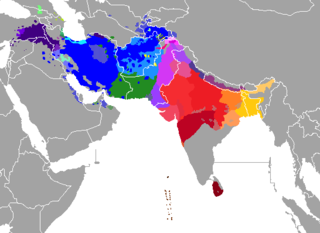
The Indo-Iranian languages constitute the largest and southeasternmost extant branch of the Indo-European language family. They include over 300 languages, spoken by around 1.5 billion speakers, predominantly in South Asia, West Asia and parts of Central Asia.

Kāfiristān, or Kāfirstān, is a historical region that covered present-day Nuristan Province in Afghanistan and its surroundings. This historic region lies on, and mainly comprises, the basins of the rivers Alingar, Pech (Kamah), Landai Sin river and Kunar, and the intervening mountain ranges. It is bounded by the main range of the Hindu Kush on the north, Pakistan's Chitral District to the east, the Kunar Valley in the south and the Alishang River in the west.

The Nuristanis are an ethnic group native to the Nuristan Province of northeastern Afghanistan and Chitral District of northwestern Pakistan. Their languages comprise the Nuristani branch of Indo-Iranian languages.

Nuristan, also spelled as Nurestan or Nooristan, is one of the 34 provinces of Afghanistan, located in the eastern part of the country. It is divided into seven districts and is Afghanistan's least populous province, with a population of around 167,000. Parun serves as the provincial capital. Nuristan is bordered on the south by Laghman and Kunar provinces, on the north by Badakhshan province, on the west by Panjshir province.

The Dardic languages, or Hindu-Kush Indo-Aryan languages, are a group of several Indo-Aryan languages spoken in northern Pakistan, northwestern India and parts of northeastern Afghanistan. This region has sometimes been referred to as Dardistan.
Âṣkuňu is a language of Afghanistan spoken by the Ashkun people – also known as the Âṣkun, Ashkun, Askina, Saňu, Sainu, Yeshkun, Wamas, or Grâmsaňâ – from the region of the central Pech Valley around Wâmâ and in some eastern tributary valleys of the upper Alingar River in Afghanistan's Nuristan Province. Other major places where the language of Ashkun is spoken are Nuristan Province, Pech Valley in Wama District, eastern side of the Lower Alingar Valley in Nurgaram and Duab districts, Malil wa Mushfa, Titin, Kolatan and Bajagal valleys.
The Katir are a Nuristani tribe in Afghanistan and Pakistan.

Khowar, or Chitrali, is a Dardic language of Indo-Aryan language family primarily spoken in Chitral and surrounding areas in Pakistan.

Dameli (دَميلي), also Damia, Damiabaasha or Gidoj, is an Indo-Aryan language of the Dardic subgroup spoken by approximately 5,000 people in the Domel Town, in the Chitral District of Khyber-Pakhtunkhwa province of Pakistan.

Kalasha is an Indo-Aryan language spoken by the Kalash people, in the Chitral District of Khyber Pakhtunkhwa province of Pakistan. There are an estimated 4,100 speakers of Kalasha. It is an endangered language and there is an ongoing language shift to Khowar.

Palula and also known as Ashreti (Aćharêtâʹ) or Dangarikwar, is an Indo-Aryan language spoken by approximately 10,000 people in the valleys of Ashret and Biori, as well as in the village of Puri in the Shishi valley and at least by a portion of the population in the village Kalkatak, in the Chitral District of Khyber Pakhtunkhwa province of Pakistan.

Gawar-Bati or Narsati is an Indo-Aryan language spoken in the Chitral region of northern Pakistan, and across the border in Afghanistan. It is also known as Aranduyiwar in Chitral because it is spoken in Arandu, which is the last village in lower Chitral and is also across the border from Berkot in Afghanistan. There are about 9,000 speakers of Gawar-Bati, with 1,500 in Pakistan, and 7,500 in Afghanistan. The name Gawar-Bati means "speech of the Gawar", a people detailed by the Cacopardos in their study of the Hindu Kush.

The Yidgha language is an Eastern Iranian language of the Pamir group spoken in the upper Lotkoh Valley of Chitral in the Khyber Pakhtunkhwa province of Pakistan. Yidgha is similar to the Munji language spoken on the Afghan side of the border.
Imra was the chief creator deity of the Nuristani people before their conversion to Islam. Imra was believed to be the creator of the earth. With his breath, it was believed, he created the three other main deities of the pantheon: Mon, Gish and Bagisht.

Kamviri is a dialect of the Kamkata-vari language spoken by 5,000 to 10,000 of the Kom people of Afghanistan and Pakistan. There are slight dialectal differences of the Kamviri speakers of Pakistan. The most used alternative names are Kati, Kamozi, Shekhani or Bashgali.
Tregami (Trigami), or Katar Gambiri, is a language spoken in the villages of Gambir, Kaṭâr, and Devoz in the Tregâm Valley off the lower Pech River in the Watapur District of Kunar Province in Afghanistan. The area is in the Hindu Kush along the border with Pakistan. Tregami belongs to the Nuristani group of the Indo-Iranian language family. It is spoken by approximately 3,500 people (2011). Most individuals speak Pashto in addition to Tregami.
Waigali, also known as Nuristani Kalasha, is a language spoken by about 10,000 Nuristani people of the Waigal Valley in the Nuristan Province of Afghanistan. The native name is Kalaṣa-alâ 'Kalasha-language'. "Waigali" refers to the dialect of the Väi people of the upper part of the Waigal Valley, centered on the town of Waigal, which is distinct from the dialect of the Čima-Nišei people who inhabit the lower valley. The word 'Kalasha' is the native ethnonym for all the speakers of the southern Nuristani languages.

Kamkata-vari is the largest Nuristani language. It contains the main dialects Kata-vari, Kamviri and Mumviri. Kata-vari and Kamviri are sometimes erroneously reckoned as two separate languages, but according to linguist Richard Strand they form one language.

The Kalasha, or Kalash, are an Indo-Aryan indigenous people residing in the Chitral District of the Khyber-Pakhtunkhwa province of Pakistan.
Disani, known in Kamviri as Disaňi and Kata-vari as Disai, from which Prasuni Disni was borrowed from, was a goddess of the Nuristani people before their conversion to Islam. To the people of Nuristan, she was depicted as living in the terrestrial world, appearing in the shape of a woman with a golden garland. Milk and milk-products were offered to her at the altar on the hillside.


















